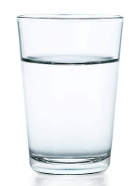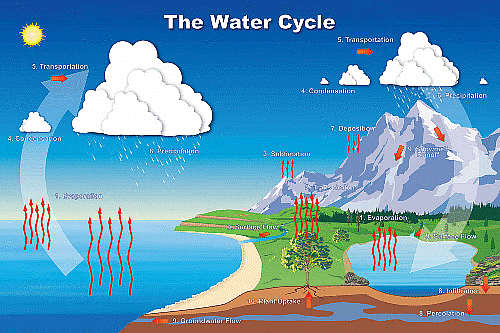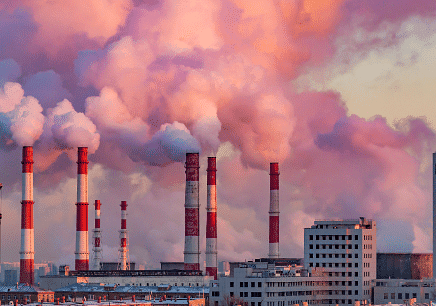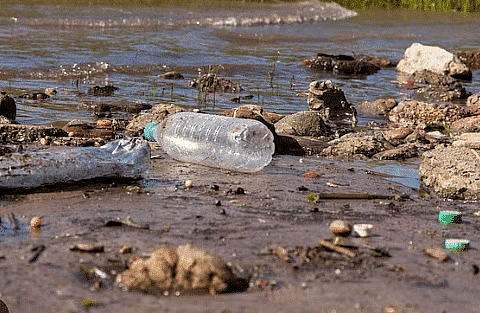Our Environment | Social Science Olympiad for Class 3 PDF Download
What is the Environment?
The environment refers to the surroundings or conditions in which living organisms exist. It includes everything around us, such as the air we breathe, the water we drink, the land we live on, the plants and animals around us, and even the weather and climate.
Components of the Environment:
- Biotic Components: Living organisms, including plants, animals, and microorganisms, form the biotic component of the environment.
- Abiotic Components: Non-living elements such as air, water, soil, sunlight, temperature, and other physical factors constitute the abiotic component.
Importance of the Environment:
- The environment provides essential resources for life, including clean air, water, and food. It also offers habitats for diverse plant and animal species.
- Environmental conditions influence climate, weather patterns, and natural cycles, impacting the overall health of the planet.
Air
Air is the invisible mixture of gases that surrounds the Earth. It's an essential part of our environment and is composed mainly of nitrogen, oxygen, carbon dioxide, and other trace gases. Here's a breakdown:
- Nitrogen (N2): The most abundant gas in the Earth's atmosphere, making up about 78% of the air. Nitrogen is vital for living organisms and various natural processes.
- Oxygen (O2): The second most abundant gas, constituting about 21% of the air. Oxygen is crucial for the respiration of animals and many other life forms.
- Carbon Dioxide (CO2): Though it makes up only a small fraction of the air (about 0.04%), carbon dioxide plays a crucial role in the Earth's climate and in supporting plant life through photosynthesis.
- Trace Gases: Other gases, such as argon, neon, helium, methane, and water vapor, make up the remaining small percentage of the atmosphere.
Air is essential for life as we know it. It provides the oxygen we breathe, allows for the transmission of sound, and plays a role in weather patterns. The atmosphere also helps regulate the Earth's temperature by trapping some of the sun's energy and preventing it from escaping back into space.
Water
Water is a clear, tasteless, and odorless liquid. It's something we can see, touch, and use every day.
Where is Water?
- In Rivers and Lakes: Imagine splashing around in a river or a lake—that's water!
- In the Ocean: The big, big water that goes on for a long, long way is called the ocean.
- In the Sky: Sometimes, you see water in the sky as clouds. When these clouds get heavy, they can give us rain.
What Can We Do with Water?
- Drink It: Water is super important for our bodies, so we drink it to stay healthy.
- Play with It: You can play with water in the bath, pool, or with water balloons on a hot day!
- Grow Plants: Plants need water to grow, just like we need food. So, water helps make everything green and pretty.
States of Water:
- Liquid: When we drink water or see it in rivers, it's a liquid. It flows!
- Solid: When it's very cold, water can turn into ice. Imagine skating on a frozen pond—that's ice!
- Gas: When water gets hot, it turns into steam. You might see it when you boil water on the stove.
Water Cycle:
Water is always moving in a big cycle. It goes up in the sky as vapor, makes clouds, falls down as rain, and goes back to rivers and oceans. It's like a big adventure for water!
Weather, Seasons and Climate
What is Weather?
Weather is what's happening in the sky and around us right now. It includes things like sunshine, rain, wind, clouds, and whether it's hot or cold.
Examples: If the sun is shining and the sky is clear, it's a sunny day. If it's raining, you'll need an umbrella. When the air is very still, it's a calm day.
What are Seasons?
Seasons are different times of the year when the weather and nature change in a pattern. There are four main seasons: spring, summer, autumn (fall), and winter.
- Spring: This is when flowers bloom, and trees get new leaves. It's often a bit rainy, and everything becomes colorful.
- Summer: Summer is when it's usually warm or hot. You can wear light clothes, and it's a great time for outdoor activities.
- Autumn (Fall): In autumn, leaves on the trees change color and fall. It gets a bit cooler, and you might see pumpkins and apples.
- Winter: Winter is the coldest season. It can snow, and you might see frost. It's a time for warm clothes and sometimes holidays like Christmas.
What is Climate?
Climate is the usual or average weather in a place over a long period of time. It's like the personality of the weather in a certain area.
Examples: Some places have a hot climate all year (like deserts), while others have cold and snowy climates (like polar regions). Some places have a mix of warm and cold seasons (like where you live).
Fun Facts:
- Weather changes every day: One day it can be sunny, the next day it might rain. That's the daily weather.
- Seasons change every few months: Spring turns into summer, then autumn, and finally winter. Each season brings different weather.
- Climate is long-term: Climate is like the usual mood of the weather in a place. If it's usually hot, it has a hot climate.
Pollution and it’s types
What is Pollution?
Pollution refers to the introduction of contaminants into the natural environment that cause adverse changes. These contaminants, often referred to as pollutants, can take various forms and may impact air, water, and land. Pollution can harm living organisms, disrupt ecosystems, and have negative effects on human health. There are several types of pollution, each associated with specific sources and consequences:
- Air pollution
- Water pollution
- Noise pollution
What is Air Pollution?
Air pollution happens when the air around us gets dirty. Instead of being clean and fresh, it has things in it that can be harmful. Imagine if the air you breathe is like the air inside a room where someone is smoking, and you don't like that because it can make you cough and feel sick.
What Makes Air Dirty?
- Smoke: Sometimes, when we burn things like wood or trash, it makes smoke that goes into the air.
- Cars and Factories: Cars and factories can let out things called "pollutants" that make the air not so nice to breathe.
- Dust and Dirt: When there's a lot of dust and dirt in the air, it can make the air not as clean and healthy.
Why is Clean Air Important?
Clean air is important because we need it to be healthy. Breathing in dirty air can make our lungs unhappy, like when we catch a cold. We want the air to be as clean as possible so that we can run, play, and stay healthy!
What Can We Do to Help?
- Plant Trees: Trees love to eat up dirty air and give us fresh, clean air to breathe. So, planting trees is like giving our Earth a big, green hug!
- Use Less Cars: When we use less cars or share rides with friends and family, we help keep the air cleaner. It's like giving the Earth a break from too much smoke.
- Throw Trash in Bins: When we throw our trash in the bins instead of burning it, we help keep the air clean and fresh.
What is Water Pollution?
 Water pollution happens when the water we use and drink gets dirty. Instead of being clean and clear, it can have things in it that are harmful. Imagine if the water you drink is like water in a pond with trash in it, and you wouldn't want that because it can make you sick.
Water pollution happens when the water we use and drink gets dirty. Instead of being clean and clear, it can have things in it that are harmful. Imagine if the water you drink is like water in a pond with trash in it, and you wouldn't want that because it can make you sick.
What Makes Water Dirty?
- Trash: When we throw things like plastic into rivers or lakes, it makes the water dirty.
- Chemicals: Sometimes, factories release chemicals into the water, which can be bad for fish and other animals.
- Dirty Rain: If the air is dirty, when it rains, it can bring that dirt down into the water.
Why is Clean Water Important?
Clean water is crucial because we use it to drink, cook, and play. If the water is dirty, it can make us sick. We want the water to be as clean as possible so that we can swim, fish, and have healthy drinks!
What Can We Do to Help?
- Throw Trash in Bins: Instead of throwing trash into rivers or lakes, we should put it in bins to keep the water clean.
- Use Less Plastic: When we use less plastic, there's less chance it will end up in the water and make it dirty.
- Plant Trees near Rivers: Just like with air pollution, trees help keep water clean too. Planting trees near rivers is like giving the Earth a big, green hug!
What is Noise Pollution?
Noise pollution happens when the sounds around us become too loud and unpleasant. Instead of having quiet and peaceful surroundings, there are noises that can be harmful. Imagine if the sounds you hear are like being in a room with too much loud music, and it bothers you because it can make you feel stressed.
What Makes Noise?
- Traffic: Cars and trucks on the road can make loud noises, especially if there's honking and loud engines.
- Machines: Some machines in factories or construction sites can be very noisy.
- Loud Music: If the music is too loud, it can become noise pollution, especially if it disturbs others.
Why is Quiet Important?
Quiet is important because our ears need a break from loud sounds. Too much noise can make it hard for us to concentrate, relax, and even sleep. We want our surroundings to be as quiet as possible so that we can focus, play, and have a good rest!
What Can We Do to Help?
- Use Headphones: If we want to listen to music or play games, using headphones can keep the sounds to ourselves and not bother others.
- Be Mindful of Noise: When we play or have fun, it's good to be aware of how loud we are so that we don't disturb others.
- Plant Trees: Trees can also help absorb sound, making places quieter. So, planting trees is like giving our ears a peaceful, green space!
Conservation of Environment
Conservation of the environment means taking care of our planet and making sure it stays healthy and beautiful. It's like being a good friend to the Earth, making sure we don't harm it and keeping it safe for all living things.
Why is Conservation Important?
- Protecting Nature: Conservation helps protect the homes of animals and plants, like forests, oceans, and rivers. It keeps their homes safe so they can live happily.
- Preserving Clean Air and Water: Conserving the environment ensures that the air we breathe and the water we drink stay clean and fresh. This is important for our health and the health of all living creatures.
- Saving Energy: Conservation also means using things wisely, like turning off lights when we don't need them or not wasting water. This helps save energy and keeps our planet happy.
What Can We Do to Conserve the Environment?
- Reduce, Reuse, Recycle: Use things wisely, don't waste, and recycle items like paper, plastic, and glass.
- Plant Trees: Trees are like Earth's superheroes. Planting trees helps keep the air clean and provides homes for animals.
- Save Water: Be mindful of using water wisely. Turn off the tap when you're not using it and fix leaks.
- Use Less Electricity: Turn off lights and appliances when you're not using them. Use energy-saving bulbs.
- Respect Nature: Treat plants, animals, and all parts of nature with kindness. Don't harm them, and remember, we share the Earth with many other living beings.
|
15 videos|16 docs|27 tests
|
FAQs on Our Environment - Social Science Olympiad for Class 3
| 1. What is pollution and its types? |  |
| 2. How does air pollution affect the environment? |  |
| 3. What are the sources of water pollution? |  |
| 4. How does soil pollution affect ecosystems? |  |
| 5. Why is it important to address light pollution? |  |
















